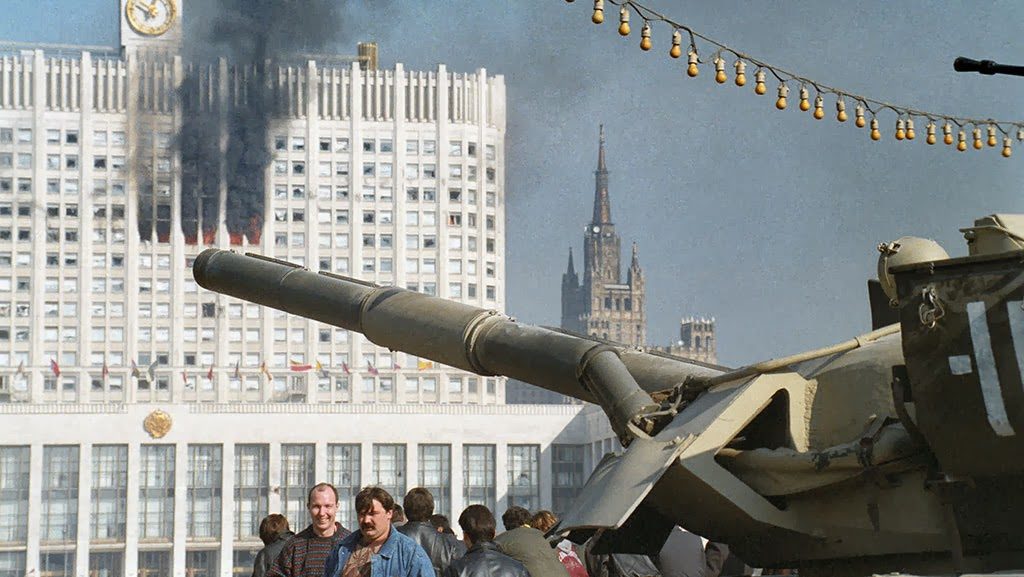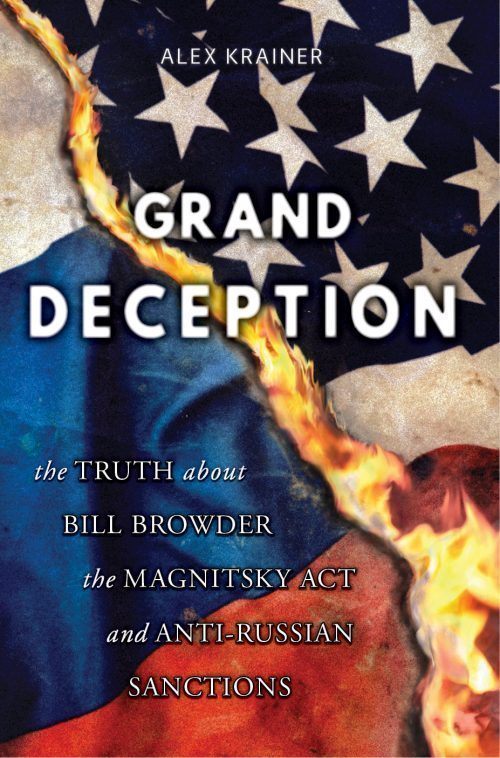"We created a virtual open shop for thievery at a national level and for capital flight in terms of hundreds of billions of dollars, and the reaping of natural resources and industries on a scale which I doubt has ever taken place in human history." ~ E. Wayne Merry, chief political analyst at the U.S. Embassy in Moscow (1990-1994)The foregoing article is an excerpt from Chapter 3 of my book Grand Deception: the Truth about Bill Browder, Magnitsky Act and Anti-Russian Sanctions. Part 1 is here.
Economic reforms and privatization were highly destructive for Russia. They were also achieved outside of the legitimate legal framework. To sidestep the government agencies and circumvent the parliament, Yeltsin's government worked through a network of private agencies and non-governmental organizations set up by Anatoly Chubais, his associates, and their western advisers. One of the most important of these organizations was the Russia Privatization Center (RPC), set up by the HIID and Anatoly Chubais under a presidential decree. RPC's directors were Andrei Schleifer and Chubais himself. Exemplifying corruption and conflicts of private and public interests in Yeltsin's cabinet, Chubais simultaneously headed the private RPC and the government's GKI (Federal Agency for State Property Management). This didn't seem to bother RPC's western sponsors; in addition to a $45 million grant from USAID, RPC obtained $59 million credit from the World Bank, $43 million from European Bank for Reconstruction and Development and further funding from the European Union, Japan and several individual European Governments.1 HIID also helped establish the Federal Commission on Securities, also with USAID's money.
Another important agency was the Institute for Law-Based Economy which was funded by the World Bank and a $20 million grant from USAID. Its mission was to help develop Russia's legal and regulatory framework. While it failed dismally at that mission, it became notorious for writing Boris Yeltsin's presidential decrees. In total USAID bankrolled Russian reforms with $325 million of US taxpayers' money. The simple objective of all this, as Richard Morningstar, another Harvard alumnus involved in the project said it, was to "win in privatizations..." 2
This framework of conflicting interests and corruption allowed Yeltsin's government to carry out the business of economic reforms and privatization unopposed by legitimate government institutions. USAID's Walter Coles put it simply enough: "If we needed a decree, Chubais didn't have to go through the bureaucracy."3 A further convenience of this network was that all actors could deflect accountability. Russian officials could defend their actions by claiming that they were following IMF or World Bank demands while Americans and other foreigners, when caught in any malfeasance, could blame the Russians for corruption.
Yeltsin cabal's blatant disregard for law ultimately provoked a violent confrontation with the Congress of People's Deputies, the legislative branch of Russia's government. In December of 1992, the deputies ousted Yegor Gaidar as prime minister and instructed the central bank to carry on issuing credit to the nation's businesses to keep them from shutting down altogether. Although Yeltsin's privilege to rule by decree expired at the end of 1992, on 20th March 1993 he granted himself extraordinary executive powers and announced a special government regime that would remain in place until the resolution of the political crisis. Three days later, Russia's Constitutional Court declared Yeltsin's measures illegal and on 26th March an extraordinary session of the ninth Congress of People's Deputies initiated impeachment proceedings against the president.
Yeltsin managed to survive the impeachment vote but continued to rule by decree and the political crisis reignited after the summer recess. On 18th September he reinstated Yegor Gaidar as deputy prime minister but the parliament strongly rejected this nomination. On 21st September Yeltsin responded by dissolving the parliament, effectively staging a coup d'état. However, the lawmakers were not about to capitulate and the political crisis continued to escalate. After the Constitutional Court ruled that the president's actions were in breach of the constitution, the parliament held an emergency session during which it declared Yeltsin's decree null and void. The deputies stripped him of the presidency and swore in the vice-president Aleksandr Rutskoy as the new president. Rutskoy's first act was to dismiss Yeltsin and his key ministers from their cabinet posts. At a session held on 24th September, the deputies announced that new elections for Russia's presidency and parliament would be held by March of 1994.
Yeltsin's violent crackdown
Lawmakers' actions were likely to lead to a halt or even revision of the privatization process. Russia's new masters had too much at stake to allow Russian democracy to obstruct their agenda.4 Boris Yeltsin responded with crude force, isolating the parliament building, cutting off its electricity, telephone lines and hot water. This provoked an open revolt among many Muscovites and tens of thousands of them descended into the streets in support of the parliament. Peaceful demonstrations went on for days and the numbers of protesters grew in spite of the news blackout of the protests. On the 28th of September, the interior ministry finally moved to suppress the demonstrations by force. This led to violent clashes between the people and the police. Still, neither the parliamentarians nor the protesters would back down. On 3rd October the protesters marched on Ostankino television station, seeking to break the media blockade and get the truth out to the rest of the Russian public. That might have catalyzed a nationwide revolt against Yeltsin's regime and the government moved ruthlessly to disperse the demonstrators. They opened live ammunition fire into the crowd that included the elderly, women and children, killing by official count 46 and wounding 124 people.
The next day Yeltsin ordered a five thousand strong army division, flanked with tanks, armored personnel carriers and helicopters, to storm the parliament. When the army tanks opened fire into the parliament building, scores of deputies and staffers were killed and wounded. When the siege was over, the President's security had orders to kill the president Aleksandr Rutskoy and the speaker, Ruslan Khasbulatov. Yeltsin's personal bodyguard Alexander Korzhakov testified that he went into the parliament building with a loaded, unlocked pistol in his right pocket looking for Rutskoy and Khasbulatov, but was unable to use it as there were too many witnesses.5
The official death toll of Yeltsin's violent suppression of the uprising against his government was 187 killed and 437 wounded.6 Unofficial figures range from 2,000 up to 5,000 casualties. In the days and weeks following the bloody storming of the parliament, Yeltsin issued a series of decrees to shore up his power, purging his political opposition, the Constitutional Court and the media outlets that supported the parliament. He took advantage of the crisis also to free the central bank from lawmakers' control and render it independent. On 12th December 1993, Yeltsin forced through a new constitution, granting himself broad powers to govern by decree and establishing a strong presidency at the heart of the Russian political system. Through this whole crisis, Yeltsin enjoyed full support and understanding from the Western powers in spite of his unconstitutional power grab, the murderous crackdown on the protesters and parliamentarians and a heavy-handed suppression of the political and media opposition.
Former US President Richard Nixon, who was a close observer of events in Russia, testified that Russian officials had informed him that the United States government supported Yeltsin's violent crackdown against the parliament on condition that his government accelerate the economic reforms.7 Indeed, shortly after the crackdown, the US Congress voted to donate $2.5 billion of American taxpayers' money to shore up Yeltsin's government. Through this bloody episode, western public was given the impression that Yeltsin was fighting an armed insurgency of hard core communist reactionaries while he himself was consistently portrayed as a committed democrat, modernizer of Russia and a friend of the west. That version of events was created through a concerted public relations effort, largely coordinated by the infamous PR behemoth Burson-Marstellar, courtesy of USAID and the unwitting American taxpayer.8
In part 3 of this series we'll look at International Monetary Fund's policies that resulted in virtual strangulation of Russian economy. As we'll see, these policies were no accident: they were premeditated and deliberate, pursued in order to facilitate wholesale looting and destruction of Russia.
Notes
- (Wedel 1998)
- Richard Morningstar was the Senior Vice President of Policy and Investment Development at the Overseas Private Investment Corporation. In April 1995 he was named as the Special Advisor to the President and Secretary of State on Assistance to the New Independent States of the former USSR.
- (Wedel 1998)
- In a 2002 testimony during a lawsuit in Cambridge, Massachusetts Lawrence Summers characterized Russian transition in these words: "The project was of enormous value..." (McClintick 2006)
- (Bodykov 2013)
- '1993 Russian constitutional crisis'. (Wikipedia)
- (Simes 2007)
- (Wedel 1998)
About the author
Alex Krainer is a hedge fund manager and author. His book, banned by Amazon in September 2017, is now available in pdf, kindle, and epub formats at the following link: Grand Deception: Truth About Bill Browder, the Magnitsky Act and Anti-Russian Sanctions. Paperback version is now available here (and on Amazon). EU-based readers can purchase it here. Alex also wrote one book on commodities trading.





Reader Comments